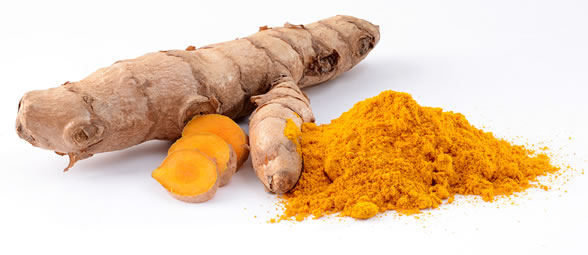Turmeric is the spice that can change your life. Yes, it can add a new flavor to your cooking, but how about being helpful with your health? From being a potent anti-inflammatory and reducer of IBS, to cancer prevention, turmeric has many benefits. Join me for a walk through this spice’s benefits, along with practical ways to get it into your daily diet.
History
Chinese and Indian systems of medicine have known about the powerful uses of turmeric for centuries. This spice is native to Indonesia, and southern India, where it has been commonly eaten for over 5,000 years. Turmeric comes from the root of the Curcuma longa plant, and has a tough brown skin and a deep orange flesh. This spice is also high in manganese, iron, and a good source of B6, copper and potassium. If you have used turmeric in cooking I am sure you understand its great ability to be used as a textile dye, it loves to turn things yellow-orange.
Turmeric Benefits
- Anti-Inflammatory, Potent, & Safe – Turmeric contains a safe, volatile oil fraction and curcumin that are natural Anti-inflammatories with affects comparable to drugs like Hydrocorisone, Phenylbutaxone, and Motrin. The great thing is turmeric does not have the toxic issues these drugs carry, like ulcer formation, decreased white blood cell count, and intestinal bleeding.
- Treatment for IBD – Curcumin is proven to be a effective treatment for inflammatory bowel disease IBD, Researchers are still trying to figure out how this exactly works, but have found very low concentrations are effective, even as little as is normally in a dish of curry.
- Rhenumatoid Arthritis Relief – Helps to neutralize free radicals which can lead to painful joint inflammation resulting in rheumatoid arthritis. Studies have shown curcumin produced positive results comparable to phenylbutazone. Results included shortened duration of moringin stiffness, lengthened walking time, and reduced joint swelling.
- Cancer Prevention – Curcumin in turmeric helped protect cellular DNA from free radical damage, and helped to destroy mutated cancer cells so they could not spread throughout the body.
- Inhibits Cancer Cell Growth in Breast Cancer – A University of Texas study showed curcumin in turmeric acted as a “master switch” to turn off the growth of breast cancer. The study was published in Biochemical Pharmacology – Sept 2005. Clinical trials at the University of Texas are now studying curcumin’s therapeutic properties with myeloma and pancreatic cancer.
- Prevent Colon Cancer – turmeric and onions were found in a Aug. 2006 study in Gastroenterology and Hepatology, to reduce the size and number of precancerous lesions in the intestinal tract.
- Prostate Cancer Halted by Turmeric & Cauliflower – Studies showed that isothiocyanates found in cauliflower, cabbage, broccoli, Brussels sprouts, and kale, combined with turmeric, retarded the growth of prostate cancer cells. It was also found to prevent prostate cancer.
- Lower Risk of Childhood Leukemia – Prof. Moolky Nagabhushan, University Medical Centre, Chicago, found that turmeric could reduce the risk of developing childhood leukemia.
- Liver Function Improved in 14 Days – A recent study showed curcumin given for 14 days resulted in improved liver detoxification by 16%.
- Turmeric Lowers Cholesterol – Turmeric improves the livers ability to clear more LDL – cholesterol from the body.
- Lowers Blood Pressure – Turmeric is a natural blood thinner which can help fight against hypertension.
- Protection Against Alzheimer’s Disease – Epidemiological studies show that in elderly Indian populations where turmeric is common, cases of Alzheimer’s are very low. Other studies have shown how Alzheimer’s symptoms reduced in individuals after introducing turmeric into the diet.
Personally, I have seen these anti-inflammatory effects. When targeting a new muscle group during workouts I have noticed stiffness and joint pain the next day. Adding some turmeric to my diet removes the discomfort overnight from my joints. Later in the article I will suggest easy ways to get this great spice into your diet.
Individual Concerns
Turmeric is not a common allergenic food and does not contain measurable amounts of oxalates or purines.
Selection & Storage
Many markets now carry turmeric, but better quality can often be found in ethnic markets or local spice stores. You may find these stores have more selection and fresher options than the common market. Always look for organic, to avoid pesticides and irradiation. To get the highest levels of curcumin, look for turmeric, not curry power. Keep your turmeric power in a tightly sealed container in a cool, dark, and dry place. Fresh turmeric rhizome should be kept in the refrigerator.
Enjoying Turmeric
- Can be easily added to salad dressings.
- Make up some curry.
- Sprinkle on sauteed apples, steamed cauliflower or green beans.
- Make a quick dip or salad dressing – mix some turmeric and dried onion with mayonnaise, salt, and pepper.
- Use turmeric in egg salad for more yellow color.
- Saute cauliflower floret halves with turmeric for 5 mins. Take to table and toss with olive oil, salt and pepper to taste.
- Experiment and find your own great way of eating turmeric.
- Be sure to add black pepper when making turmeric dishes to aid in absorption.
Too Busy to Make Food
I personally find that, when I can’t get the great turmeric foods, a supplement can be another way to receive the great benefits. One important fact to understand about turmeric supplementation: It must contain black pepper to increase absorption. Without the black pepper, the turmeric can pass through the body with very little absorption. On the supplement label this will be displayed as “BioPerine Black Pepper Extract”. There are many different makers of turmeric supplements, I currently use Youtheory Turmeric which you can get at Costco and Amazon.
Turmeric Tea
Some enjoy turmeric tea daily. Here is how:
- 4 cups of boiling water
- Add 1 teaspoon of ground turmeric
- Allow to simmer for 10 mins.
- Strain though a fine sieve into a cup
- Add honey and/or lemon to your liking
With all the great benefits that turmeric can offer, you might want to look into working it into your diet. Try it, and let us know how it works for you down in the comments section.



I have been drinking turmeric tea for the last month and I make it the easiest way possible: stir 1/4 teaspoon of organic powdered turmeric (I found in spice section of Walmart) into a cup with boiling water. Stir and sip. It settles a bit at the bottom, so I stir again from time to time. Easy and convenient. I like the taste, too. It reminds me of oil of Bergamot found in Early Grey Tea for some reason. 🙂